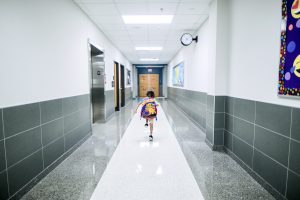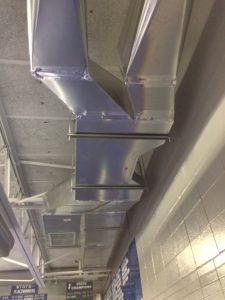If we want to open schools, mechanical ventilation is more  critical than ever.
critical than ever.
Concerns over proper airflow and indoor air quality in school buildings are not new. In more conventional times, poor IAQ in buildings contribute to asthma, allergies, cold and flu, and less productivity. Add the serious illness, potential life-long side effects, and deaths involved with COVID-19 infections and many people are questioning the safety of going back to school.
According to the United States Government Accountability Office (GAO), “an estimated 41 percent of districts need to update or replace heating, ventilation, and air conditioning (HVAC) systems in at least half of their schools, representing about 36,000 schools nationwide that need HVAC updates.” Staff and students are not oblivious to it, either!
Many school building occupants need better IAQ—especially now.
Ask staff in an older building if they believe the ventilation system causes comfort issues and/or contagion and you’re sure to get an opinion. Many school staff are retiring early to avoid catching COVID-19—some citing a lack of faith in their building’s ventilation. To be clear, decent ventilation alone will not rid indoor environments of risk entirely, but poor ventilation sure can escalate the problem. The experts are clear on the importance of bringing outdoor air into a building:
The CDC says, “Ensure ventilation systems operate properly and increase circulation of outdoor air as much as possible, for example by opening windows and doors. Do not open windows and doors if doing so poses a safety or health risk (e.g., risk of falling, triggering asthma symptoms) to children using the facility.”
ASHRAE knew COVID-19 had the potential to proliferate indoors, so it established an Epidemic Task Force back in February 2020 to advise on the matter. Of particular note is its comprehensive series of checklists for reopening schools and universities. Among its useful HVAC recommendations is to, “Consider having airflows and building pressurization measured/balanced by a qualified Testing, Adjusting and Balancing (TAB) service provider.” In addition, “Consider adjusting to maximize outdoor air or disabling operation of DCV if it will not adversely impact operation of overall system (Temporary recommendation while operating under infectious disease crisis).”
Are school districts prepared to provide enough outdoor air to their buildings?
The time to act—to upgrade school HVAC systems—was yesterday. The good news is that guidelines and solutions for preparing school buildings exist–unlike time machines. That news is of little use, however, if school districts fail to take advantage of facility down time to evaluate and improve HVAC systems when necessary. Of course, that assumes the district has the money to implement newer components or even make minor tweaks to their ventilation such as higher grade filters, ultraviolet germicidal technology, or HEPA filter units in classrooms. Many districts cannot afford to engage in optimal preparation for the new school year. It’s expensive work, and if older buildings need an entire HVAC overhaul, it likely won’t happen in time to lessen COVID infection risk to staff and students.
Superior mechanical ventilation can provide less expensive IAQ options for school districts.
When it comes to providing optimal levels of outdoor air, Energy Recovery Ventilators (ERVs) can enhance the work of air-handling units, unitary rooftop units, and direct outside air system units. They can also work as stand-alone solutions. Either way, they can support ailing HVAC systems—and in some cases replace them—as a less expensive solution. The savings doesn’t end there; ERVs save energy and reduce bills as they create comfortable environments and displace stale air on a continuous basis.
There is a BPE ERV for every indoor space. Discuss options with BPE’s IAQ experts!
At BPE, Inc., we designed superior energy recovery ventilation modules that utilize high-grade filters and offer 70% to 90% Thermal Efficiency. They also feature our patented Regenerative Condensate Return® technology for keeping relative humidity levels in range (40% to 60%). Such a range is less hospitable to Corona viruses. Our ERV units … from the BPE-XE-MIR-200-i all the way up to our industrial modular units … excel at bringing fresh outdoor air indoors to displace the air folks have been breathing into around you. And because our true direct counter-flow, air-to-air heat exchangers allow virtually no mixing of incoming and outgoing air. You’ll know you are doing your best for staff and students while bringing down your district’s energy budget.


